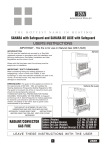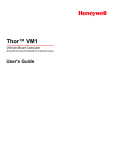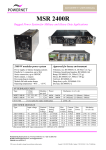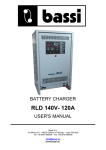Download 25,21 6&5 N9$ 2N-LINE 57 UPS
Transcript
25,216&5N9$ 2N-LINE 57UPS User Manual and Instructions Table of contents 1. Introduction................................................................................ 2 1.1 System Introduction ..........................................................2 1.2 Product Features ..............................................................3 1.3 Safety Precautions ............................................................4 1.4 Switches and Panel Indicators ..........................................6 2. Installation and Operation.......................................................... 7 2.1 Unpacking and Inspection.................................................7 2.2 RACK Installation ..............................................................7 2.3 Wiring Method ...................................................................8 2.4 ON and OFF operation of the unit.....................................8 2.5 Battery Maintenance .........................................................9 3. Troubleshooting....................................................................... 10 3.1 Led and Diagnostic audio alarms .................................... 10 3.2 Troubleshooting .............................................................. 10 3.3 Significance of alarm sounds .......................................... 12 4. Time Endurance of Batteries ................................................... 12 5. Communication Interface Port ................................................. 13 6. Electrical Specification ............................................................ 14 6.1 Input ............................................................................... 14 6.2 Output............................................................................. 15 6.3 Internal Battery Pack ..................................................... 16 6.4 End of Discharge Voltages ............................................. 16 6.5 Mechanical Requirements .............................................. 16 6.6 Audible Noise.................................................................. 17 1 Battery Pack 1. Introduction 1.1 System Introduction This rack-mounted UPS can be installed into a 19” rack, placed together with all your networking equipment, Hub Switches and Remote Routers in a single computer equipment room so that all devices are protected by the UPS; the setup has a fashionable look, too. Our rack-mounted UPS is a state-of-the-art, ideal, on-line and fully uninterrupted power supply system. Sine-wave output accompanied with bypass switching provides a reliable and high quality AC power source. The wide range of application covers computer equipment, communication systems and industrial automation facilities. Thanks to the On-line design, the device provides functions such as voltage regulation, mains filtration and frequency drift prevention in normal operation. During a power outage, the stand-by battery pack will switch-in to maintain a sustained power supply. Under an overload or inverter failure, the UPS device will automatically switch-over to bypass mode for the system to be powered by the Power Mains; when the overload condition is eliminated, the system will automatically switch back to inverter mode. All the switching over takes place within 4ms, so that your equipment operates continuously without any interruption. Figure of Front Panel Status indication and control Selection interface Figure of Rear Panel Input switch Communication Interface Maintenance SW. Fan Output Switch Plug for external Battery 2 1.2 Product Features 1.2.1 Electrical properties Input Output Loading and Capacitance (KVA/KW/PF) Voltage 3-Wire + GND Current L1 or L2 PFC Input Voltage 3-Wire + GND L1-N & L2-N L1-L2 L1-L2 Phase difference 5.4/3.78/.70 100/200 21.6 A 100/200 27.0 A 27.0 A 180° 6.0/4.2/.70 110/220 21.9 A 110/220 27.3 A 27.3 A 180° 6.0/4.2/.70 115/230 20.9 A 115/230 26.1 A 26.1 A 180° 5.2/4.2/.81 120/208 23.1 A 120/208 25.0 A 25.0 A 120° 6.0/4.2/.70 120/240 20.0 A 120/240 25.0 A 25.0 A 180° Current Note 1: When overload capacity>130% ±10%, trip to bypass after 10 seconds. When overload capacity>200% ±10%, trip to bypass after 8 cycles. Note 2: In case the input is 100VAC L-N, the UPS can only be used up to 90% capacity. Wiring duct 3 1.2.2 Mechanical specifications Model NO. Dimensions (mm) W×D×H Net weight 35 Online 6kva RT 120v 176×615×430 31 35 Weight (kg) It is strictly forbidden to expose the battery or battery pack to fire, or explosion and injury may occur. Never dismantle or damage the battery arbitrarily, or else the battery fluid may spill out. The battery fluid is highly corrosive; it may cause severe injury to the skin and eyes if touched. Shorting electrodes of the battery will cause risks of high voltage and high electric current. Placing magnetic objects upon the UPS may cause data loss or damage. In order to secure safe and continued operation, the user must observe the regulations for using the UPS correctly and the following precautions: 1.3 Safety Precautions Detailed safety regulations All the safety regulations described in this manual shall be strictly observed during the installation and maintenance of the UPS and battery assembly. Note: The UPS unit contains a battery pack which is very heavy; in order to prevent the rack from falling over, the UPS unit shall be positioned as low as possible in the rack. Connect the UPS to a socket furnished with a circuit breaker or fuse protection and capable of sustaining a current of at least 30A. To ensure normal operation, this device shall not be used to power electric drills, vacuum cleaners or laser printers, for which transient starting current is high. The UPS contains high voltage; in case of any problem, please consult a professional or contact the service center for assistance to prevent any injury. The UPS carries the power of the battery pack; the output may carry an output voltage even if the UPS is disconnected from the power mains. The rated voltage of the internal battery pack is 144VDC. Grounding wire – a non-loading PVC wire that is green or green with narrow yellow strips. The grounding wire depicted above denotes the connection wire that connects the metal casing of the device to the ground. The maintenance and replacement of the battery pack shall be carried out by a trained UPS professional. No other personnel shall be allowed to manipulate the UPS. When replacing the battery, observe the principle of consistency in the quantity, brand and model number. In case of any problem resulting from the customer using batteries other than that approved, the customer shall be held responsible. 4 Do NOT open the outer cover of the UPS. Avoid placing the UPS in an environment of high temperature and humidity. Do NOT pour any liquid or poke any object into the UPS. Do keep the venting slots in the front, rear and sides unclogged. Avoid exposing the UPS to direct sunshine and avoid placing it near a heat source. High-voltage Risks: Note: High-voltage will be present between a battery electrode and the ground if the battery circuitry and input voltage are not isolated. Check any electrode for high-voltage before touching it. Note: Even if the UPS is disconnected from the power mains, internal parts of the UPS are still connected to the battery pack. Therefore a potential risk exists. Make sure the battery jumpers are disconnected before performing any maintenance or repair. Warning: Batteries will age with the time. When aging occurs, consult professionals for regular replacement or treatment, or the battery fluid may leak, causing fire or other hazards. We suggest regular maintenance to check the batteries once a year. Note: Batteries tend to age and gradually lose their capacity when used at the normal temperature (approx. 25°C). A normal lifespan is 2-3 years. If batteries are used with frequent cycles of charging and discharging, the lifespan will be further shortened. 5 1.4 Switches and Panel Indicators (1) (2) (3) (4) (5) (6) (7) Power switch: Press the “On/Mute” button on the front panel to switch the UPS on. Press the “Off” button on the front panel to switch the UPS off. AC INPUT indicator (Green): When this indicator lights up, the power mains input is normal. BATTERY indicator (Yellow): When this indicator lights up, the UPS is powered by the battery pack. BYPASS indicator (Yellow): When this indicator lights up, the UPS unit is supplying power of the Power Mains to the output via bypass. UPS ON indicator (Green): When this indicator lights up, the UPS is supplying power to the output through the inverter. Fault indicator (Red): In case of any anomaly of the UPS, this indicator lights up and a continuous audio alarm sounds. Load capacity indicators (4 green lamps and 1 yellow lamp) or battery capacity indicators (5 green lamps): Number of lit lamps indicates the percentage of load or battery capacity. Designation of indicators is as follows: (from left to right as in the following diagram of indicators on the panel.) 2. Installation and Operation 2.1 Unpacking and Inspection In case of any damage of the carton package, please contact the shipper immediately. For the purpose of further shipment or storage, please place the packaging material in the carton and store them properly. 2.2 RACK Installation 2.2.1 Slide Rail Accessories include: Item Quantity Front rail 2 Rear rail 2 Inner rail 2 M4 * 8mm screw 16+16 M4 nut 8 M5 * 16mm screw 12 Handle 2 RACK front rail bracket Front rail M5 bolt Rear rail RACK rear rail bracket M5 bolt Fig. 1 2.2.2 Device box bracket assembly process: M4 Nut M4 Bolt (1) Adjust the front and rear sliding rails to the same length as the RACK, fix the front and rear ends of the slide rails to the RACK using 8 M5 bolts, as shown in Fig.1. (2) Lock the front rails and the rear rails using 8 M4 bolts and 8 M4 M4 bolt nuts as shown in Fig.2. (3) Fix the handle and inner rails to both sides of the RACK using 16 M4 bolts, with the lock latch on the inner rail facing the rear of the RACK, as shown in Fig.3. M4 Nut Fig. 2 Inner rail Latch UPS Rack Front panel Handle 6 7 Fig. 3 M4 bolt (4) Check and tighten all bolts, then insert the UPS cabinet into the rails on the RACK with the rear side of the cabinet slanting up, then lift the front side of the cabinet to a horizontal position as shown in Fig.4 and push the cabinet into position inside the RACK. (5) Finally fix the cabinet front panel handles to the front brackets of the RACK using 4 M5 bolts so that the UPS unit does not fall out of the RACK. Fig. 4 2.3 Wiring Method (1) (2) At least 10AWG (soft) or 22mm² (hard) wires shall be used for the input and output wires. Wiring the input: In case of 3-phase 4-wire 208/120V power system (with R, S, T, N, and G wires) taking any 2 phases as the power input, the Neutral wire (N) must be connected too. and the “BYPASS” indicator will go out. At this point, the UPS unit has entered into normal operation. In case the bar-type indicator indicates a load exceeding 100%, the buzzer will beep every half second, alerting the user that excessive load has been connected to the system. You may disconnect loads of secondary devices such as printers. If the “Power Mains” indicator lights up, the AC power source is correctly connected. If both the “Power Mains” and “Battery” indicators light up at the same time, it indicates that the voltage or frequency of the AC source has exceeded its range. (2) UPS I/P breaker off: Checks and confirms that the standby function of the battery is normal. The UPS unit will beep every 4 seconds. The Power Mains indicator goes out. (3) Press the “OFF” button (**Note**) ( Pressing the “OFF” button once will switch the load devices over to the bypass circuit for standby power supply. Pressing the “OFF” button a second time within 4 seconds will disengage the output socket(s) and the connected load device(s) from power. Please turn off all the connected loads according to all necessary procedures before pressing the “OFF” button twice. (4) The UPS unit has “DC (battery) start up” and “alarm mute” functions. When the Power Mains fails, the load indicator will function as a “Battery Capacity Indicator” during standby. Direct start up in Battery Mode: When there is no Power Mains input, press the “ON/Mute” button to start the UPS unit for a Battery Mode start up. The first-time use of “DC (battery) start up” is only available when the unit has been started with the Power Mains. Alarm Mute: Pressing the “ON/Mute” button will stop the alarm. Pressing the button again will re-activate the alarm. Please note every button needs to be pressed for more than 1 second for activation. 2.5 Battery Maintenance 1. UPS output 2. Input of power When the UPS unit is not in use, the battery shall be re-charged every three months for at least 12 hours. In warm areas, charge the battery every two months for at least 12 hours. Batteries tend to age when in operation. In general, batteries have a lifespan of 3-5 years. An aged battery must be replaced, or the battery may leak battery fluid and create a fire hazard. 2.4 ON and OFF Operation of the Unit (1) After verifying correct wiring to the Power Mains, press the “On/Mute” button and the load indicator on the panel lights up. Check indicators one by one. A few minutes later, the inverter indicator “UPS ON” will light up 8 9 3. Troubleshooting AC input LED blinks When you call for service, please provide the following information: Date and time of the problem, product model and serial number. Detailed description of the event and the status of panel indicators at the time of event. Battery LED lights UPS has no input up power 3.1 LED and diagnostic audio alarms Status of Anomaly LEDs and Load LEDs Diagnoses/ Audio Alarms All LEDs light up Tripped to Bypass due to output overload; beeps every half a second LED A lights up Tripped to Bypass due to output overload; beeps (1s or 2s) every 4 seconds LED B lights up Tripped to Bypass due to Bus overvoltage; beeps (1s or 2s) every 4 seconds LED C lights up Tripped to Bypass due to failure of control power; beeps (1s or 2s) every 4 seconds LED D lights up Tripped to Bypass due to PFC failure; beeps (1s or 2s) every 4 seconds LED E lights up Tripped to Bypass due to INV failure; beeps (1s or 2s) every 4 seconds LEDs A&B light up INV-to INV communication anomaly; beeps every half a second LEDs A&C light up Battery test anomaly; beeps (2s) every 60 seconds. LEDs A&D light up L1 & L2 phase failure LEDs B&C light up REPO activation LEDs C&E light up Command given from interface for UPS shutdown; no alarm activation LEDs D&E light up Charger overvoltage: Beeps (1s) every 4 seconds Power Mains LED lights up; Battery LED blinks Battery not installed or battery low voltage; constant beeping Bypass LED blinks Bypass voltage or frequency exceeds range 3.2 Troubleshooting Problem Possible cause UPS battery operation time shortens Frequency of power mains exceeds UPS rating by ±5% range. UPS output frequency not synchronized with Power Mains. Please check UPS input for normal frequency. May be that the power source is a generator. UPS is operating in Battery Mode; please check that the input socket of the UPS is in normal condition. UPS input protecting fuse broke up or Input NFB tripped. UPS is operating in Battery Mode; please save data and close application programs. Replace input fuse of UPS, then restart UPS. Switch ON input NFB again. Voltage of Power Mains exceeds input range of the UPS. UPS is operating in Battery Mode; please save data and close application programs. Make sure Power Mains is within the voltage range acceptable to the UPS. Battery not fully charged. Keep UPS plugged in for at least 24 hours to fully charge the battery. UPS overload. Check load level display and reduce loads from UPS. Aged battery unable to Replace the battery. Please call your local reach full charge. dealer or service personnel; purchase batteries as specified. Fault and Bypass UPS overload or failure Check load level display and remove LEDs and all load- of loaded devices. unnecessary loads from the UPS. Re-calculate level LEDs light up and reduce loads connected to the UPS. Check load devices for failure. Fault & Bypass UPS internal fan LEDs light up and failure, or UPS shuts LED A lights up down due to excessive temperature. Make sure the UPS is not overloaded. Check if vents are clogged and the surrounding temperature is maintained within a proper range. Waite for 30 minutes to cool down the UPS. If the UPS cannot be restarted, call your local dealer or service personnel. When the UPS is UPS internal failure. in fault and any of LEDs A through E light up The UPS needs to be serviced. Please call your local dealer or service personnel. Power Mains LED Battery cable detached/ Check the battery circuit; restart UPS after fully lights up and not connected. switching off the unit. Remark: If the battery Battery LED blinks circuit is disconnected during the UPS operation, the next battery test will detect this condition. Remedy UPS does not start UPS output short circuit Make sure the power supply to the UPS is or overload switched off. Remove all the load devices. when ON button Make sure no load device is connected to the pressed output socket. Verify that none of the load devices has an internal failure or short. 10 11 3.3 Significance of alarm sounds Significance 5. Communication Interface Port Alarm Sounds Battery mode (Power Mains failure) One beep every 10s Battery voltage low Two short beeps every 5s Output overload (Bypass) One short beep every 0.5s Overheat (Bypass) One beep (1s or 2s) every 4s Inverter (INV) failure (Bypass) One beep (1s or 2s) every 4s Bus overvoltage (Bypass) One beep (1s or 2s) every 4s Battery test failure One beep (2s) every 60s INV-to-INV communication failure One short beep every 0.5s 4. Time Endurance of Batteries Load proportion (linear load) Internal battery 10% 75 20% 38 30% 25 40% 18 50% 60% 14 11 70% 9 80% 7 90% 6 100% 5 The RACK-installed UPS has a standard DB-9 female serial port. This port provides several signals and their respective functions are given as follows: Pin Function 1 Low battery power (transistor collector open, see the figure below). 2 UPS TxD (normal RS-232 transmission) 3 UPS RxD (normal RS-232 transmission) 4 Switched off by remote control (max. 5-12 VDC,10-24mA) during the battery operation mode. 5 Common ground for pins 2, 3, and 4 6 Switched off by remote control (pin 5 shorted) during any operation mode. 7 Low battery power (transistor collector open; see the figure below). 8 Abnormal Power Mains input (transistor emitter open; see the figure below). 9 Abnormal Power Mains input (transistor collector open; see the figure below). Pin Assignment Collector to Emitter Open collector Open emitter Remark: At 25°C environment temperature, in minutes. Discharge time will shorten as the battery ages; it is recommended that the battery be replaced every 3-5 years. 12 Note: Maximum allowable voltage and current fed into pins 1, 7, 7 and 9 are 60VDC/10.0mA. If these values are exceeded, internal optical couples of the UPS may get burnt. Pin 4 – Explanations of remote control switch off of battery operation 1. This pin is only functional when the UPS is in battery mode. Pin 4 will ignore any signal when the UPS is in the normal mode where the Power Mains is in normal supply. 2. Pin 4 requires a 5-12 VDC signal to switch off the unit. A 5-12 VDC signal sustained for more than 1.5s is required for switch off of the unit; any signal shorter than 1.5s will be ignored. When Pin 4 receives a switch off signal 13 longer than 1.5s, this signal can no longer be canceled. 3. The UPS is not switched off immediately after the receipt of a switch off signal at Pin 4; instead, the unit starts a 2-minute timer and the switch off will only take place after 2 minutes. Note: the switch off timer cannot be stopped midway once it is activated. 4. In case the Power Mains resumes supply during the 2-minute countdown, the timer still fulfills the countdown and switches off the UPS. The UPS will remain OFF for at least 10s before automatically resuming the LINE MODE, even if the AC input is resumed before the UPS is switched off. 6. Electrical Specification Input frequency Bypass Protection Limits Disable Bypass operation Re-enable Bypass operation Note - If the transfer points are specified using L-N voltages, the L-L voltage will depend upon whether the inverters are 120 or 180 degrees apart. For reference, this table shows the equivalent L-L voltages for the specified L-N voltages. Angle Max VAC (120 + 25%)L-N / L-L High Line Transfer (120 + 17%)L-N / L-L Low Line Transfer (120 – 25%)L-N / L-L 180 150 / 300 140 / 280 90 / 180 120 150 / 260 140 / 242 90 / 156 6.2 Output Model: 6kva 120v/240v 6.1 Input Model: 6kva 120v/240v Acceptable L-N Input Voltage without damage Acceptable input frequency without going to batteries Low Line Transfer Voltage Range With 110, 115, 120, 127 Nominal L-N (based on % loading) Low Line transfer High Line transfer Input power factor Note – At a nominal line voltage of 127 VAC, the maximum AC input will be reached before 127 + 15% and the unit will go to battery mode before the bypass reaches the disable voltage, so 127 +15% can be ignored. 0-150 VAC Note 3 40-70Hz; 0.1 L1-N or L2-N voltage, whichever is less 100-90% / 90-70% / 70-30% / 30-0% 90 / 80 / 70 / 60 VAC; 3.1 VAC 140 VAC; 3.1 VAC 0.97 at full resistive load, nominal input conditions 0.95 at half load 40 Hz to 70 Hz; ±0.1 Hz If input voltage exceeds ±15% of the nominal voltage If input voltage returns to within ±10% of nominal output voltage Note - The intent of low and high line transfer and comeback voltages is to establish about 7 VAC of hysteresis. The ±3.1 VAC tolerance is to mean that if the transfer point is +2 VAC, then the retransfer point should also be about +2 VAC. If the low line transfer point is +3.1 VAC and the retransfer point is –3.1VAC, the hysteresis could be reduced to 0.8 VAC. To prevent this, the voltage error should be in the same direction and about the same magnitude for each transfer point voltage pair. 14 Power Load may be all L-N, all L-L, or mixed Power (kVA) max. Power (kW) max. Load Power Factor Range Output Voltage Waveform Nominal L1-N & L2-N Voltages Line Mode RMS Voltage Battery Mode RMS Voltage Transfer Time Output Voltage Distortion Linear Load Non-Linear Load (no load to full load) Output Frequency Synchronization Range Capture Range Synchronization Range Capture Range Free-Running Mode AC Efficiency 6.0 (110V derated to 5.4 kVA) 4.2 (110V derated to 3.78kW) 0.65 lagging to 1.0 (unity) Sinusodial 120 VAC (Factory default setting) L1-N, L2-N = 3 % of nominal, L1-L2 = 5 % of nominal; no load to full load, resistive & RCD loads L1-N, L2-N = 3 % of nominal, L1-L2 = 5 % of nominal; no load to full load, resistive & RCD loads 0 mS 3% THD, R load 5% THD, RCD load 50 Hz nominal operation 46.5 Hz - 53.5 Hz; ±0.1 Hz 47 Hz - 53 Hz; ±0.1 Hz 60 Hz nominal operation 56.5 Hz – 63.5 Hz; ±0.1 Hz 57.0 Hz – 63.0 Hz; ±0.1 Hz 0.1 Hz of nominal 15 88 % AC-AC, minimum 6.6 Audible Noise 112 to 130 %, 10 %; for 10 seconds minimum, then transfer to bypass 131 to 200 %, 10 %; for 2 seconds minimum, then transfer to bypass > 201 %, 10 %; for 96 msec minimum, then transfer to bypass UPS Model Noise Level 6000 VA 55 dBA Max Line Mode Overload Capability Inverter overload Inverter overload Inverter overload 6.3 Internal Battery Pack (all parameters are defined at 25 degC) Rating / Type Voltage Back-up Time (at 25 degC) Extended Battery Capability Recharge Time (internal battery) Model: 6kva 120v/240v and External Battery Cabinets 12V / 9AH 144Vdc nominal, 12 x 12V 5 minutes minimum at full rated load Yes, through safe connector on rear of UPS Six hours to 90% capacity after discharged into full load at nominal input voltage Environmental Requirements The UPS will be capable of withstanding the following environmental conditions: ** Ambient Temperature Range Operating: 0 degC to +40 degC for altitude 0 to 1500 meter above sea level Non-operating: -15 degC to +50 degC ** Humidity: 0% to 95% non-condensing 6.4 End of Discharge Voltages The end of discharge shutdown voltage will be based on the total runtime. Discharging time 50 minutes, 50minutes < Discharging time 4Hrs, 4Hrs < Discharging time Batt Vcutoff = 9.6V/pcs Batt Vcutoff = 10V/pcs Batt Vcutoff = 10.5V/pcs 6.5 Mechanical Requirements (generally 4U UPS with 2U VBATT for 19 inch rack) Model Width (tower) /Height (rack) 6 KVA UPS 4U External Battery 2U 176 mm (6.93 in) 87 mm (6.93 in) Depth (incl. handles) 592 mm (20.55 in) 592 mm (20.55 in) Height (tower) /Width (rack) 430 mm (16.93 in) 430 mm (16.93 in) Orion Power Systems Service and Technical Support If you have any problems or questions with the UPS, call your local distributor or Orion Power Systems technical support at the following telephone number : In the United States: 1-877-385-1654 Please have the following information ready when you call: - Model number and Serial number - Description of failure or problem - Date of failure or problem - Customer contact information and return address If repair is necessary, you will be given a Returned Material Authorization (RMA) number. The RMA number must appear on the outside of the box and on the Bill Of Lading. Original packaging should be used if available. Systems that get damaged in transit as a result of improper packaging are not covered under warranty. A replacement or repair unit will be shipped, freight prepaid for all units under warranty. NOTE: For critical applications, immediate replacement may be available. The 4U UPS will use one UPS bezel and one battery bezel from the 2U UPS models. The 2U battery cabinet will use one 2U battery bezels 16 17



















